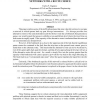Free Online Productivity Tools
i2Speak
i2Symbol
i2OCR
iTex2Img
iWeb2Print
iWeb2Shot
i2Type
iPdf2Split
iPdf2Merge
i2Bopomofo
i2Arabic
i2Style
i2Image
i2PDF
iLatex2Rtf
Sci2ools
TRANSCI
1998
1998
Queue Spillovers in Transportation Networks with a Route Choice
This paper explores some of the traffic phenomena that arise when drivers have to navigate a network in which queues back up past diverge intersections. If a diverge provides two alternative routes to the same destination and the shorter route has a bottleneck that generates a queue, one would expect that queue to stabilize at an equilibrium level where the travel time on both routes is roughly equal. If the capacity of the alternative route is unlimited then this network can accommodate any demand level. However, if the bottleneck is so close to the upstream end of the link that the equilibrium queue cannot be contained in the link, then the trip time on the queued route cannot grow to match that on the alternate route. This means that the alternative route can never be attractive, even if the queue spills back past the diverge, and that drivers approaching the diverge will act as if the alternative route did not exist. As a result, a steady flow into the system greater than the capa...
| Added | 23 Dec 2010 |
| Updated | 23 Dec 2010 |
| Type | Journal |
| Year | 1998 |
| Where | TRANSCI |
| Authors | Carlos F. Daganzo |
Comments (0)

